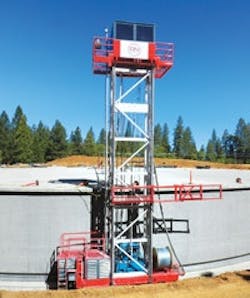Fostering Sustainable Poultry Processing
Set in the agricultural fields of the San Joaquin Valley in Northern California, the family-owned Foster Poultry Farms Chicken Processing Complex is located in the city of Livingston. Established in 1939, it is the largest employer in both the city and Merced County and processes approximately 500,000 chickens a day. The company is a leading poultry producer in the western U.S. and specializes in a variety of chicken and turkey products branded as fresh, locally born and humanely raised on its own farms in each of its markets.
The Foster Farms processing plant complex consisted of two processing plants, a rendering plant, a delicatessen plant, and other ancillary and support facilities, all of which generated a large amount of wastewater every week. Disposal of this waste posed a challenge because it contained high concentrations of organic matter, as well as nutrients such as phosphorous and nitrogen.
Previously, process water from the plant complex was discharged to the city of Livingston’s wastewater treatment facility, which provided wastewater collection and treatment exclusively for Foster Farms. Poultry wastewater was pretreated using fine screening, flow equalization and dissolved air flotation thickening on site, and then was flowed by gravity from Foster Farms to the city’s treatment plant for further processing and beneficial reuse.
After several years of working with the city to develop a long-term plan, Foster Farms elected to design and build its own industrial wastewater treatment plant (WWTP) on approximately 6 acres of its existing land. Reid Eng. was selected as the prime engineer; Kaweah Construction Co. as the general contractor; and DN Tanks as the storage tank designer, builder and prestressor of the two largest reactors.
Special Considerations
Based on the amount of treated water going through the proposed plant, it was determined that DN Tanks should design, build and prestress two 2.3-million-gal reactors: one anoxic and one nitrification. The floors, footings and walls were designed and constructed with concrete. Each tank design featured an inside diameter of 117 ft, a wall height of 30 ft, and a 10-in.-thick cast-in-place corewall.
Specialized seismic connections were incorporated between the wall-to-wall footings, similar to a base isolation system in essential buildings, to account for the high seismic forces anticipated over the service life of the tank. The connections were designed to allow for maximum ductility under a seismic event to ensure the structures would continue to perform should the tanks undergo horizontal and vertical ground accelerations.
The tank corewalls were circumferentially and vertically prestressed by DN Tanks. All corewalls were post-tensioned vertically with 1/4- to 1-in.-diameter high-strength threadbars and subsequently grouted with epoxy. The circumferential prestressing was conducted with a strandwrapping machine, which applied the desired force to the 3/8-in.-diameter hot-dip galvanized seven-wire strand. The machine continuously and electronically monitored the applied stressing force. By keeping the corewalls in compression along with the independent connections, long-life, liquid-tight structures were ensured. After strandwrapping, the strand was encapsulated with several coats of machine-applied shotcrete.
In pursuing a more sustainable method of poultry product waste disposal, Foster Farms began a joint partnership with the East Bay Municipal Utility District (EBMUD). Poultry blood was sent from Foster Farms via trucks to EBMUD, where it ran through the utility’s wastewater treatment process for anaerobic digestion and methane recovery. EBMUD used the methane gas to power its treatment plant and generate electricity for nearby communities.
This partnership exemplified a model of collaboration between a private poultry processor and a public utility district, resulting in an agreement that established a successful organic waste disposal solution for both organizations by utilization of shared facilities. The new treatment system represented a significant improvement over the existing pond system. In addition, environment management systems were in place at each facility to ensure adherence to water quality standards and measure improvements.
A Good Neighbor
Completion of the new WWTP reflected a vital contribution to the well-being of the Livingston community by providing a reliable, environmentally safe waste disposal system. Foster Farms always has taken measures to ensure the safety and integrity of the local environments in which it operates and it takes pride in being a good neighbor. The company not only generated additional property tax revenue for the city of Livingston and Merced County, but it provided approximately 3,500 jobs and supported local poultry farms and trucking firms.
Download: Here
